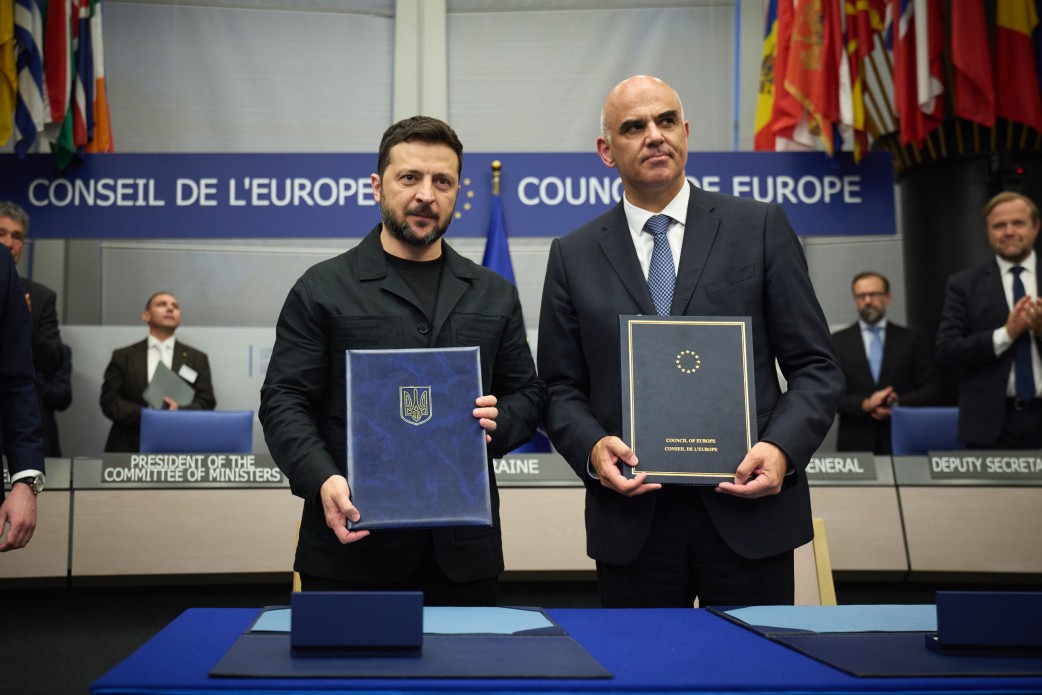On June 25, 2025, President Zelenskyy, on behalf of Ukraine, signed an Agreement with the Council of Europe on the establishment of a Special Tribunal for the Crime of Aggression Against Ukraine.
Earlier, on June 24, as Ukrainian media reported, the Committee of Ministers of the Council of Europe held an extraordinary meeting, where Alain Berset was authorized to sign a bilateral agreement with Ukraine. The final text of the Tribunal's Statute was also published.
OPORA analysed this document and identified its most important features.
1. Principle of Inevitability of Punishment: How the Statute Overcomes Immunities
One of the greatest obstacles in international law has always been the immunity of high-ranking officials. The Tribunal's Statute resolves this issue directly and uncompromisingly. Article 4 establishes that no official position—be it president or minister—exempts a person from criminal responsibility.
Why is this important? Without this norm, the Tribunal would be practically powerless, as its main targets are precisely those people who are usually covered by functional or personal immunity.
Practical consequences. The Prosecutor's Office can initiate investigations, gather evidence, prepare indictments, and request arrest warrants for any person, regardless of their current position. Even if the trial of a sitting head of state is postponed, the mere existence of an international arrest warrant turns such a person into an internationally isolated criminal.
This norm transforms the Tribunal from a symbolic body into a real mechanism capable of holding accountable those who consider themselves untouchable.
2. Voice of the International Community: The Source of the Tribunal's Legitimacy
For court decisions to carry weight, they must be perceived as objective and impartial. The Statute lays a strong international foundation for this, as the Tribunal is not just a Ukrainian court with international elements, but is established on the basis of an international agreement between Ukraine and the Council of Europe. Its activities are financed and controlled by a Management Committee (Article 13), which includes representatives from various states, and its administrative and financial rules are borrowed from the Council of Europe (Article 51).
Why is this important? Such a structure distances the Tribunal from accusations of “victor's justice” or political bias. It acts not on behalf of one state, but on behalf of the international community, which condemns aggression as such.
Practical consequences. The international composition of judges and prosecutors, as well as oversight by dozens of states, gives the Tribunal's verdicts maximum legitimacy. This makes their recognition and enforcement significantly easier anywhere in the world.
Ultimately, it is the international architecture that gives the Tribunal the moral and legal power to speak the language of global justice.
3. Strategic Focus: Why the Tribunal Aims for the "Big Fish"
Resources for international justice are limited, so they must be used as effectively as possible. Thus, Article 1 of the Statute clearly limits the Tribunal's jurisdiction to "persons who bear the greatest responsibility."
Why is this important? This is a deliberate strategic choice. Instead of prosecuting thousands of perpetrators, the Tribunal focuses on those who planned, initiated, and directed the aggression. As a result, deep and complex investigations can be conducted into the chain of command and political decisions that led to the war.
Practical consequences. This approach complements the work of other courts, rather than competing with them. For example, the International Criminal Court and Ukrainian courts can focus on war crimes and crimes against humanity committed on the battlefield, while the Special Tribunal will address the root cause—the act of aggression itself.
By focusing on the "architects" of the war, the Tribunal aims not just to punish the guilty, but to create a powerful precedent that will make similar aggressions impossible in the future.
4. Justice Without Obstacles: 'In Absentia' Mechanism and Guarantees of Justice
The Statute answers the question: "What to do if the accused are hiding and do not appear in court?" Article 28 allows for trials in the absence of the accused (in absentia) if they evade justice or have knowingly waived their right to be present.
Why is this important? This mechanism does not allow criminals to paralyze the justice process and ignore it. The trial can move forward, evidence can be presented, and a verdict can be issued.
Practical consequences. This is not "justice at any cost." The Statute contains a key guarantee: if a person convicted in absentia is arrested, they have the right to a new trial in their presence (Article 28(3)).
This approach perfectly combines effectiveness (justice does not stop) and fairness (the fundamental rights of the accused are protected).
5. Step-by-Step Formation and Termination of the Tribunal's Activities
Specific provisions of the Statute outline the mechanisms for launching and terminating the Tribunal's work. Article 53 provides for its phased establishment. Initially, it starts without jurisdiction—for appointing staff and developing rules. Then, after an agreement is concluded with the host state, the full structure of the court will be formed, allowing for the organization of the process and the establishment of cooperation for effective evidence collection. Article 54 regulates the dissolution of the Tribunal after the completion of all proceedings, providing for the creation of a residual mechanism that will continue to perform important functions, such as overseeing the enforcement of judgments and protecting witnesses.
Why is this important? This comprehensive approach is critically necessary to ensure the continuity of justice and the effective use of resources.
Practical consequences. Phased launch minimizes chaos and delays, and clear rules for dissolution and the creation of a residual mechanism ensure that justice will be brought to fruition even after the Tribunal's main mandate is completed. This also increases the institution's credibility and legitimacy, as its activities are transparent and predictable from beginning to end.
All of this makes the Tribunal an effective tool for holding the guilty accountable.
Read more:
Arrest Warrants for Putin and Lvova-Belova: What is Their Impact and What Has Changed in a Year? (in Ukrainian)
